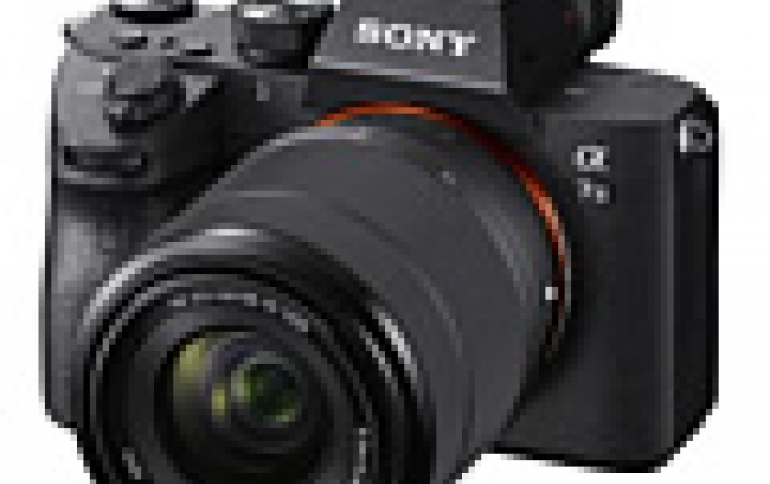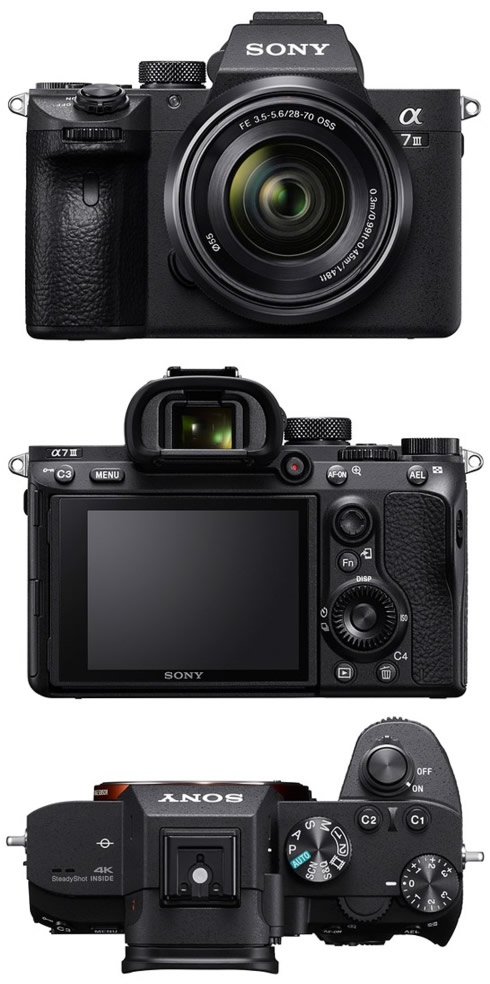
New Sony a7 III 24MP Full Frame Mirrorless Camera Retails For Less Than $2,000
Sony has announced the a7 III, a sub-$2000 image-stabilized 24MP full frame mirrorless camera that incorporates many of the features and improvements brought in with the a9 and a7R III.
The new camra features a new 24.2MP back-illuminated Exmor R CMOS image sensor with increased sensitivity, resolution and a 15 stops of dynamic range at low sensitivities. By combining this sensor with a variety of features including extreme AF coverage of 93%, fast shooting at up to 10 fps with either mechanical shutter or silent shootingiv, diverse 4K video capabilities and more, Sony has created a new tool that gives all types of creators - from enthusiast to professional - the ability to capture content in new and different ways.
The 24MP sensor is a BSI design but doesn't gain the super-fast readout of the a9's more sophisticated 'stacked CMOS' sensor. This means it can't match the a9's top shooting speed of 20fps and doesn't offer that camera's "anti-distortion shutter." The a7 III's fully electronic shutter takes around 1/18th of a second, rather than the roughly 1/160th of a second that the a9 takes.

These components work together to allow the camera to shoot fast while also enabling an impressive ISO range of 100 - 51200 (expandable to ISO 50 - 204800 for still images) and an overall 1.5-stop improvement in image quality. The camera also features a 15-stop dynamic range at low sensitivity settings.
This new full-frame model can also output 14 bit RAW format even in silent and continuous shooting modes, and is equipped with a 5-axis optical image stabilisation system that results in a 5.0 step shutter speed advantage.
The new α7 III full-frame mirrorless camera features a level of AF performance that has been improved over the α7 II, including the addition of 4D FOCUS capabilities. The new camera has 425 contrast AF points that work with a 693-point focal-plane phase-detection AF system inherited from the α9 model. This AF system covers approximately 93% of the frame, ensuring reliable focusing and tracking for even the most difficult to capture subjects.
AF response and tracking has also been improved in the new camera, with almost 2x the focusing speed in low-light condition and 2x the tracking speed compared to the previous model as a result of the faster image sensor readout.
The Eye AF feature is also available in the new camera, even in AF-C mode, which is useful for situations where the subject is turning around, looking down or otherwise obstructed. It also works when the α7 III is being used with Sony's A-mount lenses with an optional LA-EA3 adaptor. Additional improvements in focusing flexibility include the addition of a multi-selector or 'joystick' for moving focusing points quickly, the addition of touch focusing capability, AF availability in Focus Magnifier mode, an 'AF On' button and much more.
The new α7 III is equipped with an updated image processing system that allows it to shoot full resolution images at up to 10 fps with continuous AF/AE tracking for up to 177 Standard JPEG images, 89 compressed RAW images or 40 uncompressed RAW images. This high speed mode is available with either a mechanical shutter or a completely silent shooting. The camera can also shoot continuously at up to 8 fps in live view mode with minimal lag in the viewfinder or LCD screen.
For added convenience, while large groups of burst images are being written to the memory card, many of the cameras key functions are operable, including access to the 'Fn' (Function) and 'Menu' buttons, image playback and several other menus and parameters including image rating and other functions that facilitate on-location image sorting.
Additionally, if there is fluorescent or artificial lighting present in a shooting environment, users can activate the Anti-flicker function to allow the α7 III to automatically detect frequency of the lighting and time the shutter to minimise its effect on images being captured.
The new α7 III is a video camera as well, offering 4Kv (3840x2160 pixels) video recording across the full width of the full-frame image sensor. In video mode, the camera uses full pixel readout without pixel binning to collect about 2.4x the amount of data required for 4K movies, and then oversamples it to produce high quality 4K footage.
An HLG (Hybrid Log-Gamma) picture profile is available on the α7 III as well, which supports an Instant HDR workflow, allowing HDR (HLG) compatible TV's to playback 4K HDR imagery. Further, both S-Log2 and S-Log3 are available for increased colour grading flexibility, as well as Zebra functionality, Gamma Display assist and proxy recording. The camera can also record Full HD at 120 fps at up to 100 Mbps, allowing footage to be reviewed and eventually edited into 4x or 5x slow motion video files in Full HD resolution with AF tracking.
Sony's newest full-frame camera is equipped with a variety of capabilities that were first implemented in the α9 and then again in the α7R III. These include dual media slots, with support in one slot for UHS-II type SD memory cards. Users have a variety of options for storing their content in each of the cards, including separate JPEG / RAW recording, separate still image / movie recording, relay recording and more. Battery life has been greatly extended as well - with a CIPA measurement of up to 710 shots per charge.
The α7 III features high-resolution XGA OLED Tru-Finder with approximately 2.3 million dots. It also is capable of transferring files to a smartphone, tablet, computer or FTP server via Wi-Fi, while also offering a SuperSpeed USB (USB 3.1 Gen 1) USB Type-C Terminal for increased flexibility in power supply and faster image transfer speed during tethered shooting.
The α7 III will ship in Europe in March, 2018 priced at approximately €2300 (body only) or €2500 in a kit with the SEL2870 lens.





















